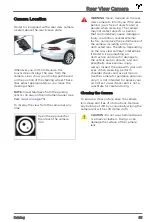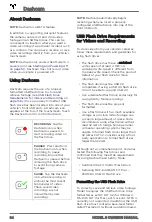
◦
Standard
: Provides the maximum
amount of regenerative braking.
When you release the accelerator,
Model S slows down, reducing the
need to use the brakes.
◦
Low
: Limits regenerative braking.
When you release the accelerator,
Model S takes longer to slow down
and coasts further than if set to
"Standard".
Stopping Mode
Regenerative braking decelerates Model S
whenever you release the accelerator pedal
when driving. You can choose what you want
Model S to do once the driving speed has
been reduced to a very low speed (almost at
a stop) and both the accelerator pedal and
brake pedal are released. While in Park, touch
Controls
>
Driving
>
Stopping Mode
and
choose from these options:
•
CREEP
: When close to, or at, a complete
stop, the motor continues to apply
torque, moving Model S slowly forward (in
Drive) or backwards (in Reverse), similar
to a conventional vehicle with an
automatic transmission. In some
situations, such as on a steep hill or
driveway, you may need to press the
accelerator pedal to continue moving or
to prevent Model S from moving in the
opposite direction.
WARNING:
Never rely on CREEP
to apply enough torque to prevent
your vehicle from rolling down a
hill. Always press the brake pedal
to remain stopped or the
accelerator pedal to proceed up
the hill. Failure to do so can result
in property damage and/or a
collision.
•
HOLD
: Maximizes range and reduces
brake wear by continuing to provide
regenerative braking at speeds lower than
with the Creep and Roll settings. When
Model S stops, the brakes are
automatically applied without you having
to put your foot on the brake pedal.
Whether stopped on a flat surface or a
hill, Vehicle Hold keeps the brake applied,
provided your foot remains off the
accelerator and brake pedals. See
.
WARNING:
Never rely on HOLD to
adequately decelerate or fully stop
your vehicle. Many factors can
contribute to a longer stopping
distance, including downward
slopes, the low regenerative
braking setting, and reduced or
limited regenerative braking (see
Regenerative Braking on page 69
).
Always be prepared to use the
brake pedal to adequately
decelerate or stop.
•
ROLL
: When close to, or at, a complete
stop, Model S becomes free rolling like a
vehicle in Neutral. Therefore, if stopped
on a slope, Model S will roll downward.
The brake does not engage, and the
motor does not apply torque (until the
accelerator pedal is pressed).
NOTE:
If you choose CREEP or ROLL, you
can still use Vehicle Hold to apply the
brakes. However, you will need to briefly
press the brake pedal when the vehicle is
stopped. See
WARNING:
Press the brake pedal if
Model S moves when unsafe to do so.
It is your responsibility to stay alert
and be in control of the vehicle at all
times. Failure to do so can result in
serious damage, injury, or death.
WARNING:
Do not rely on
regenerative braking and your chosen
Stopping Mode to keep you and your
vehicle safe. Various factors such as
driving with a heavy vehicle load, on a
steep hill, or on wet or icy roads affect
deceleration rate and the distance at
which Model S will come to a stop.
Drive attentively and always stay
prepared to use the brake pedal to
stop as appropriate based on traffic
and road conditions.
WARNING:
Forward Collision Warning
and Automatic Emergency Braking do
not operate when driving at very low
speeds (see
). Do not rely on these
features to warn you, or to prevent or
reduce the impact of a collision.
NOTE:
Your chosen setting is retained in your
Driver Profile until you manually change it.
Braking and Stopping
70
MODEL S OWNER'S MANUAL
















































